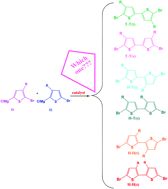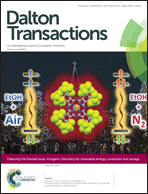Exploring the mechanism of Grignard metathesis polymerization of 3-alkylthiophenes†
Abstract
In this study we have investigated computationally the mechanism of polymerization of 2,5-dibromo 3-butylthiophene via the GRIM method, with the focus on the origin of the head to tail (HT) selectivity. To this end, first the Grignard reagent underwent oxidative addition to the monomer to afford the 2-bromo-5-chloromagnesio-3-butylthiophene (intermediate I1) or the 2-chloromagnesio 5-bromo-3-butylthiophene (intermediate I2) regioisomers. Then intermediates I1 and I2 were polymerized catalytically to a series of regiospecific poly-3-butylthiophenes using the commonly used Ni(dppp)Cl2 [dppp: 1,3-bis(diphenylphosphino) propane] and Pd(dppp)Cl2 catalysts. Due to the asymmetric nature of I1 and I2 that act as the active monomeric species, 6 coupling modes may occur. The whole energy profile of all modes has been studied by considering a three-stage mechanism, including coordination, transmetalation, and reductive elimination, to compare quantitatively the ability of so-called catalysts in selective coupling of desired isomers to produce regioregular poly-3-butylthiophene. Finally, to quantify the steric role of the dppp in regioselectivity, analysis of the buried volume in terms of steric maps was performed.


 Please wait while we load your content...
Please wait while we load your content...